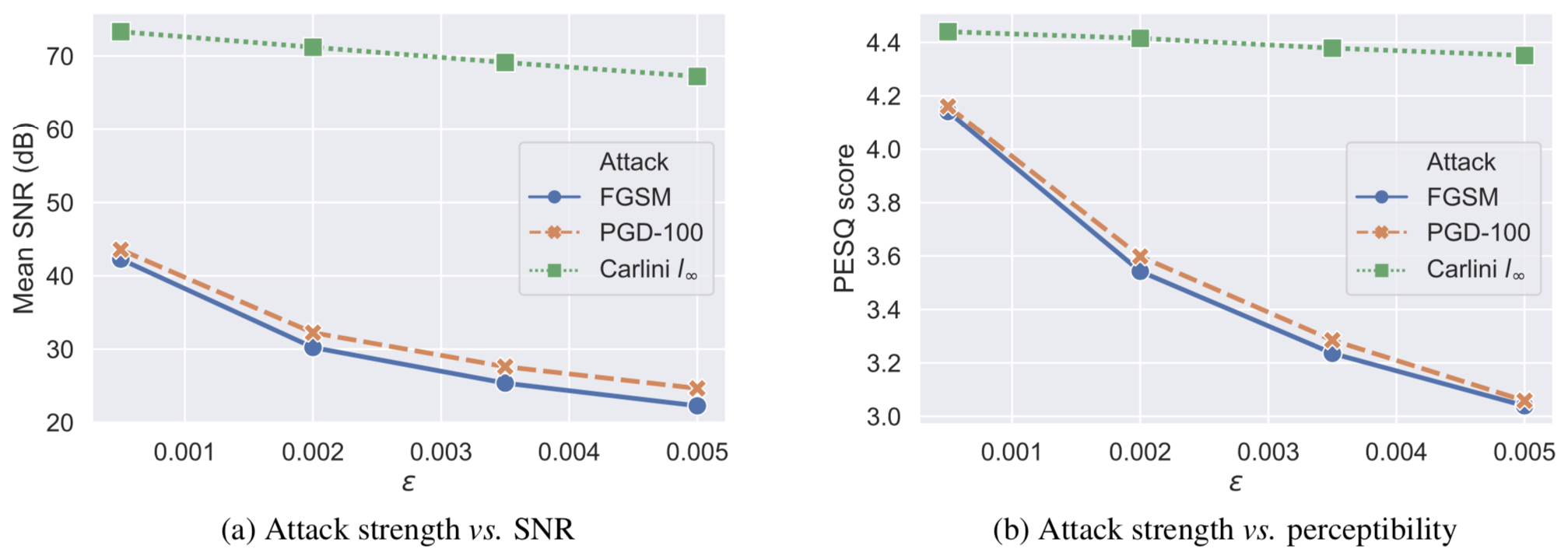This repository contains the source codes for performing time-domain adversarial attack on a deep neural network based speaker recognition model. It also provides implementation of defense methods via adversarial training and adversarial Lipschitz regularization [1]. The core implementation of the attack and defense algorithms is based on the Adversarial Robustness Toolbox (ART) and the original implementation of [1].
We perform extensive analyses on adversarial attack and defense strategies for a deep speaker recognition model.
- Time-domain adversarial attack
- Extensive analysis of the effect of multiple state-of-the-art white box adversarial attacks on a DNN-based speaker recognition model. Algorithms:
FGSM [2], PGD [3], and Carlini-Wagner [4] - Multiple defensive countermeasures for the deep speaker recognition system, and detailed comparison. Algorithms:
adversarial training [2,3], adversarial Lipschitz regularization (ALR) [1] - Transferability analysis
- Various ablation studies (e.g., varying the strength of the attack, measuring signal-to-noise ratio (SNR) and perceptibility of the adversarial speech samples via PESQ scores [5])
Accuracy scores ([0,1] scale) for the undefended model (standard training), and three defense methods against several state-of-the-art adversarial attacks.

Published on Elsevier Computer, Speech and Language
Link: https://www.sciencedirect.com/science/article/pii/S0885230821000061
@article{JATI2021101199,
title = {Adversarial attack and defense strategies for deep speaker recognition systems},
journal = {Computer Speech & Language},
volume = {68},
pages = {101199},
year = {2021},
issn = {0885-2308},
doi = {https://doi.org/10.1016/j.csl.2021.101199},
url = {https://www.sciencedirect.com/science/article/pii/S0885230821000061},
author = {Arindam Jati and Chin-Cheng Hsu and Monisankha Pal and Raghuveer Peri and Wael AbdAlmageed and Shrikanth Narayanan},
}
More detailed information about the experiments can be found in the paper: https://arxiv.org/abs/2008.07685
Please cite us if you find the paper/source code useful.
@misc{jati2020adversarial,
title={Adversarial Attack and Defense Strategies for Deep Speaker Recognition Systems},
author={Arindam Jati and Chin-Cheng Hsu and Monisankha Pal and Raghuveer Peri and Wael AbdAlmageed and Shrikanth Narayanan},
year={2020},
eprint={2008.07685},
archivePrefix={arXiv},
primaryClass={eess.AS}
}
Create your virtual env, and then install the dependencies.
conda create -n adv_spkr python=3.6
conda activate adv_spkr
First, install pytorch 1.4.0 yourself depending on the configuration and GPU availability of your machine. Then,
pip install -r requirements.txt
- CentOS Linux release 7.7.1908 (Core)
- python 3.6
Data preparation: LibriSpeech
Please download LibriSpeech train-clean-100 dataset from http://www.openslr.org/12/, and extract (uncompress) it. This should extract everything in a directory named LibriSpeech/.
Set data_root in hparams.py
e.g.,
self.data_root = /data/speech if /data/speech/ contains the extracted LibriSpeech/ folder.
It might be easier to just look at the following bash script, and execute it with the default / other suitable parameters.
sh run.sh
Otherwise, you can also directly work with the python scripts as shown below.
model_dir=models/
mkdir -p $model_dir
MODEL_CKPT=${model_dir}/model.pt
OUTPUT_DIR=outputs/
mkdir -p $OUTPUT_DIR
MODEL_TYPE=cnn
python train_libri.py \
--model_type $MODEL_TYPE \
--model_ckpt $MODEL_CKPT \
--batch_size 128 \
--num_workers 16 \
--n_epochs 30 \
--log $OUTPUT_DIR/results_train.txt
ATTACK=FastGradientMethod
EPS=0.002
python test_libri.py \
--model_type $MODEL_TYPE \
--model_ckpt $MODEL_CKPT \
--output_dir $OUTPUT_DIR \
--attack $ATTACK \
--epsilon $EPS \
--report $OUTPUT_DIR/report.md \
--log $OUTPUT_DIR/results_test.txt
--model_ckpt should point to the pre-trained model we just trained above.
Other ATTACK options are: ProjectedGradientDescent, CarliniLInfMethod, CarliniL2Method.
Add --save_wav 1 if you want to save the adversarial examples.
The output adversarial samples can be found in $OUTPUT_DIR.
run_defence.sh
Or, work with the python scripts as shown below.
MODEL_TYPE=cnn
DEF_OUTPUT_DIR=defense_outputs
mkdir -p $DEF_OUTPUT_DIR
DEF_MODEL_CKPT=$DEF_OUTPUT_DIR/model.pt
python train_adversarial_libri.py \
--model_type $MODEL_TYPE \
--model_ckpt $DEF_MODEL_CKPT \
--num_epochs 30 \
--epsilon 0.002 \
--ratio 0.5 \
--attack_max_iter 10 \
--attack ProjectedGradientDescent \
--log $DEF_OUTPUT_DIR/results_train.txt
ALR_WEIGHT=1
N_ITERS=500000
python train_libri.py \
--model_type $MODEL_TYPE \
--model_ckpt $DEF_MODEL_CKPT \
--batch_size 128 \
--alr_weight $ALR_WEIGHT \
--n_iters $N_ITERS \
--num_workers 32 \
--log $DEF_OUTPUT_DIR/results_train.txt
Same as testing an undefended model, just use the defended pre-trained model path in --model_ckpt=$DEF_MODEL_CKPT.
sh run_tdnn_transfer.sh
Or the following step-by-step guide.
Train a source model SRC_MODEL_CKPT with standard training as described above.
TGT_MODEL_CKPT=models/tdnn-model.pt
OUTPUT_DIR=transfer_expt/
mkdir -p $OUTPUT_DIR
python train_libri.py \
--model_type tdnn \
--model_ckpt $TGT_MODEL_CKPT \
--batch_size 128 \
--num_workers 16 \
--n_epochs 3 \
--log $OUTPUT_DIR/results_train.txt
python transfer_test.py \
--model_ckpt $SRC_MODEL_CKPT \
--target_model_ckpt $TGT_MODEL_CKPT \
--output_dir $OUTPUT_DIR \
--attack $ATTACK \
--epsilon $EPS \
--attack_max_iter $MAX_ITER \
--report $REPORT \
--log $OUTPUT_DIR/results_transfer_test.txt
[1] Dávid Terjék. Adversarial lipschitz regularization. In 8th International Conference on Learning Representations, ICLR 2020, Addis Ababa, Ethiopia, April 26-30, 2020. OpenReview.net, 2020.
[2] Ian Goodfellow, Jonathon Shlens, and Christian Szegedy. Explaining and harnessing adversarial examples. In International Conference on Learning Representations, 2015.
[3] Aleksander Madry, Aleksandar Makelov, Ludwig Schmidt, Dimitris Tsipras, and Adrian Vladu. Towards deep learning models resistant to adversarial attacks. In International Conference on Learning Representations, 2018.
[4] Nicholas Carlini and David Wagner. Towards evaluating the robustness of neural networks. In 2017 IEEE symposium on security and privacy (sp), pages 39–57. IEEE, 2017.
[5] ITU-T Recommendation. Perceptual evaluation of speech quality (pesq): An objective method for end-to-end speech quality assessment of narrow-band telephone networks and speech codecs. Rec. ITU-T P. 862, 2001.

